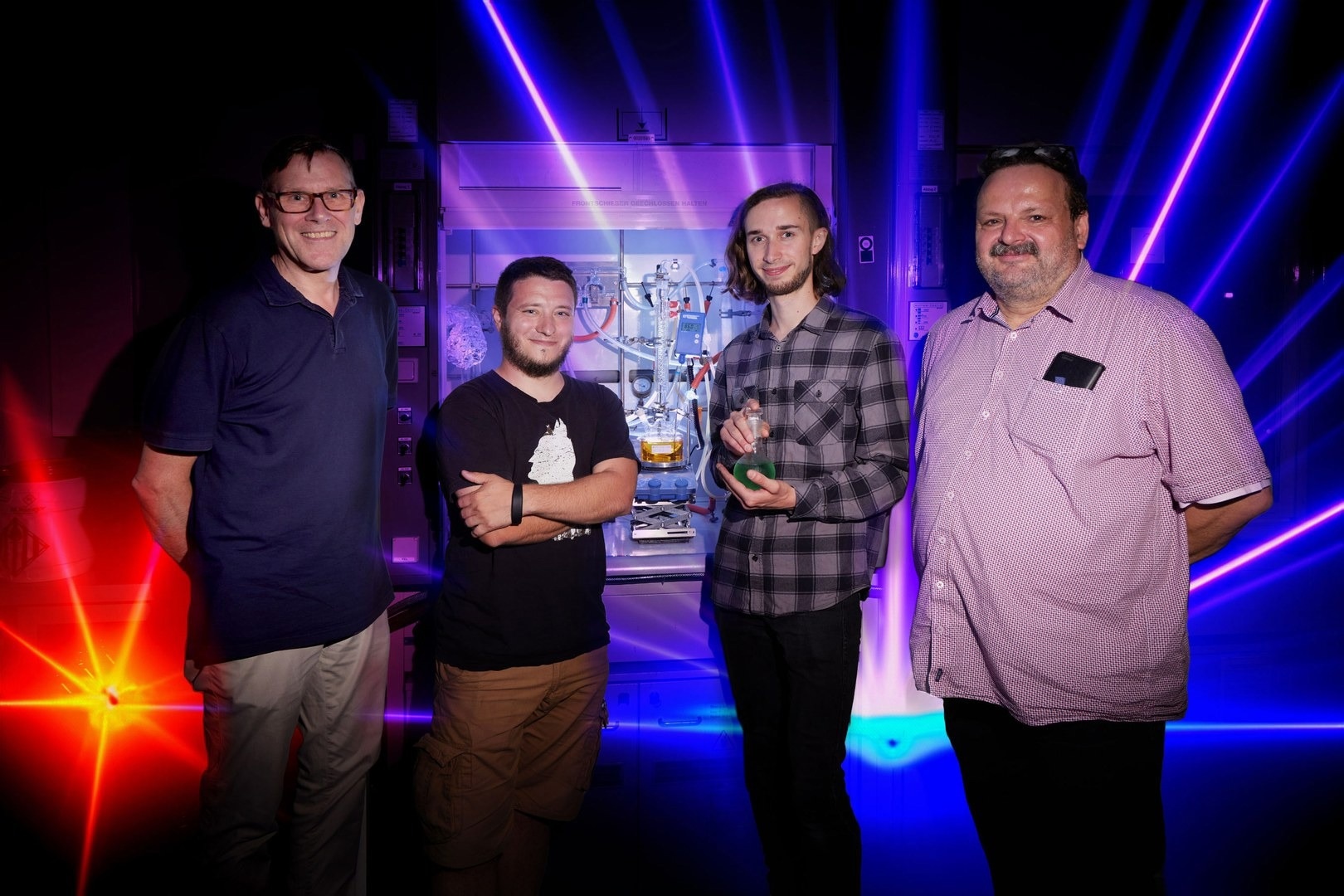Chemical processes that were previously nearly impossible have been made feasible using a revolutionary catalysis method. The process created at the University of Bonn is eco-friendly and does not require rare or expensive metals. A type of high-speed film was used by the researchers to capture the precise progression of the catalysis.
 At the experimental setup (from left): - Prof. Dr. Peter Vöhringer, Dr. Luis Domenianni, Jonas Schmidt and Prof. Dr. Andreas Gansäuer. Image Credit: Volker Lannert/University of Bonn
At the experimental setup (from left): - Prof. Dr. Peter Vöhringer, Dr. Luis Domenianni, Jonas Schmidt and Prof. Dr. Andreas Gansäuer. Image Credit: Volker Lannert/University of Bonn
The team utilized specialized lasers that can render visible processes that last just a few billionths of a second, using the findings to further tune the catalyst. The results were published in Angewandte Chemie’s international edition.
Take playing golf as an example. The golf ball must traverse a brief slope on the course to enter the hole behind it. It must be struck firmly enough to do this. If not, it will roll back toward the person who hit it instead of overcoming the obstruction.
Many chemical processes have an energy threshold that must be reached before they can continue. However, when a catalyst is employed, this threshold - referred to as activation energy - decreases.
Some reactions are even only made possible by the use of catalysts.
Dr. Andreas Gansäuer, Professor, Kekulé Institute for Organic Chemistry and Biochemistry, University of Bonn
Titanium Instead of Precious Metals
Dr. Andreas Gansäuer is located at the University of Born's Kekulé Institute of Organic Chemistry and Biochemistry and has been researching ways to make the manufacturing of carbon compounds easier for years. The method of choice to do this usually involves the use of a catalyst. However, these “reaction accelerators” are made of rare and expensive metals like platinum, palladium, or iridium.
Gansäuer added, “We usually use titanium compounds instead. This is because titanium is one of the most abundant elements in the earth’s crust and is also completely non-toxic.”
On the other hand, titanium-based catalysts frequently require a partner to accelerate chemical processes. This is usually a metal as well. It stimulates the catalyst, is consumed in the process (unlike the latter), and produces by-products as waster.
This is both costly and not very sustainable. However, there have been attempts for some time to achieve this activation in a different way: By irradiating the catalyst with light. We have now implemented this idea. At the same time, we filmed, in a sense, the processes that occur during activation and catalysis.
Dr. Peter Vöhringer, Professor, Clausius Institute for Physical and Theoretical Chemistry, University of Bonn
Lasers Create “Lightning Storm”
The researchers’ “high-speed camera” was a spectrometer, which is a complicated equipment that can be used to identify what a molecule appears like at a given instant in time. A flash is also required for this to operate.
The researchers do this by using a laser that alternately turns on and off. Each of the dazzling moments lasts only a few hundred femtoseconds (a femtosecond is one millionth of a billionth of a second). As a result, the catalytic process is divided into a series of distinct images.
Not every molecule lends itself to easy filming.
“We therefore had to make some modifications to the titanium catalyst we usually use,” Gansäuer stated.
The results of this study demonstrate that the compound can be stimulated by light and can then catalyze a certain type of redox reaction. Electrons are transferred from one reactant to the other in redox reactions.
Gansäuer further noted, “This process is facilitated by the activated catalyst. This allows us, for example, to produce compounds that serve as starting materials for many important drugs.”
Greedy for Electrons
The “high-speed film” captures every detail of light activation.
Electrons resemble a compass needle that points in a certain direction. This spin changes as a result of irradiation.
Jonas Schmidt, Postdoctoral Student, University of Bonn
In a metaphorical sense, this makes the titanium complex “greedier” to receive an electron. When it happens, the redox reaction begins.
Vöhringer added, “Thanks to the insights we have gained with our method, we can now further optimize the catalyst.”
Chemical reactions that were before scarcely imaginable could now be performed with it. The accomplishment is also a sign of effective collaboration between laser and molecular physics and organic chemistry.
“Our study shows the fruits that can come from collaboration between two research groups with completely different methodological backgrounds,” Vöhringer concluded.
The German Research Foundation (DFG) and the Manchot Foundation provided funding for the study.
Journal Reference:
Schmidt, J., et al. (2023) Observing the Entry Events of a Titanium-Based Photoredox Catalytic Cycle in Real Time. Angewandte Chemie. doi:10.1002/anie.202307178